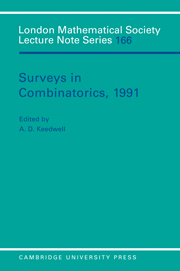Book contents
- Frontmatter
- Contents
- Preface
- “Radar Signal Patterns from Combinatorial Designs”
- “Old and New Results on Ovals of Finite Projective Planes”
- ”Schubert Polynomials“
- “Computational Methods in Design Theory”
- “Unprovable Combinatorial Statements”
- “Orientations and Edge Functions on Graphs”
- “Graph Perturbations”
- “A Graph Reconstructor's Manual”
- “Turán Type Problems”
“Old and New Results on Ovals of Finite Projective Planes”
Published online by Cambridge University Press: 05 September 2013
- Frontmatter
- Contents
- Preface
- “Radar Signal Patterns from Combinatorial Designs”
- “Old and New Results on Ovals of Finite Projective Planes”
- ”Schubert Polynomials“
- “Computational Methods in Design Theory”
- “Unprovable Combinatorial Statements”
- “Orientations and Edge Functions on Graphs”
- “Graph Perturbations”
- “A Graph Reconstructor's Manual”
- “Turán Type Problems”
Summary
The classical concept of a conic leads in a natural way to the concept of an oval in an arbitrary projective plane: An oval is a subset Ω of points satisfying both of the following properties: i) no three points of Ω are col linear; ii) Q has exactly one 1-secant (also called a tangent) at each one of its points. If the plane is finite and has order n, then an oval consists of n+1 points.
Ovals of finite projective planes have been intensively studied since 1954. The starting point was the famous theorem of B. Segre [94], [95]: In a Desarguesian plane of odd order, the ovals are exactly the irreducible conies.
This paper is a survey of known results in the following areas:
1) The classification problem for ovals in a desarguesian plane of even order.
2) Ovals in finite non desarguesian planes.
3) Pascal's theorem for ovals and abstract ovals.
4) Collineation groups fixing an oval; some characterizations of the finite desarguesian planes.
THE CLASSIFICATION PROBLEM FOR OVALS IN A DESARGUESIAN PLANE OF EVEN ORDER
In 1956 Segre pointed out that his result on the characterization of conies cannot be extended to desarguesian planes of even order. The classification of ovals in these planes is still an open problem and seems to be very complex.
We give a brief account of the known ovals in desarguesian planes of even order, but for detailed information concerning the extensive theory of ovals developed by Segre and his school the reader is referred in particular to the books [53], [98]. Quite recently, some new investigations have been carried out. Details will be found in the survey papers [15], [80].
- Type
- Chapter
- Information
- Surveys in Combinatorics, 1991 , pp. 41 - 72Publisher: Cambridge University PressPrint publication year: 1991
- 5
- Cited by

